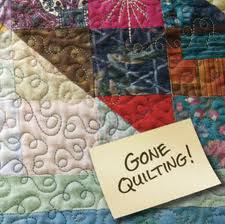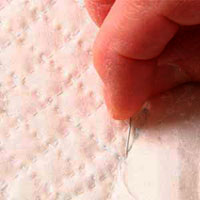 In the French family, we sleep under quilts. Even when a duvet is involved, a quilt absolutely must lie atop it. We are used to the weight of them, and among the five of us, own around three dozen. Each one of these was handmade, stitch-by-stitch, by my mother. To get an idea of the scope of this, she quilts daily, and a single quilt takes over a year to complete. She does not believe in idle hands, or more precisely, cannot relate to them. Last year I found a melon-sized rubber band ball sitting on her desk, held it up to my brother and asked, simply, “Why?” “Because,” he said, “It’s what she does. She makes things.”
In the French family, we sleep under quilts. Even when a duvet is involved, a quilt absolutely must lie atop it. We are used to the weight of them, and among the five of us, own around three dozen. Each one of these was handmade, stitch-by-stitch, by my mother. To get an idea of the scope of this, she quilts daily, and a single quilt takes over a year to complete. She does not believe in idle hands, or more precisely, cannot relate to them. Last year I found a melon-sized rubber band ball sitting on her desk, held it up to my brother and asked, simply, “Why?” “Because,” he said, “It’s what she does. She makes things.”
My whole life I have slept under one or another of my mother’s quilts, some of which were blue ribbon winners in the Bishop County fair. I dragged them to boarding school in Canada, college in Scotland, then Boston, and back to California again. During a Laura Ingalls Wilder phase, I began to pretend I was huddled up beneath one on the back of a covered wagon. I still like to imagine this when I can’t fall asleep.
I remember her quilting a lot at night, after dinner, while watching Murder She Wrote (replaced now by NCIS) but there was also a time when she quilted in the mornings. I had just started a preschool for “special” children in Santa Monica, run by two psychiatrists whose philosophy stressed fostering “feelings of self-worth” and the ability to “manage” in a group setting. They also required parents to stay at the school until all parties, including the child, agreed upon separation. For most children, even the really anxious ones, this took a few weeks. For me, six months felt safe. And so for half a year, after I had white knuckled the cuff of her sleeve at the prospect of painting pictures of my feelings, my mother spent half-days away from her studio, sitting in a playground, quilting. At recess she let the other kids do a stitch each, because giving mildly disturbed children a needle is a really good idea.
 A couple of decades later, I decided it was time I started quilting for myself. This was two months ago, when my dad got sick, and when, shortly afterwards, the guy that I am desperately in love with fell out of love with me. I’m pretty old for my first broken heart, but there you have it. My mother has often said that quilting, once the creative part of deciding upon your shapes is done, is “blissfully mindless”, just stitch after stitch, which sounded pretty good to me.
A couple of decades later, I decided it was time I started quilting for myself. This was two months ago, when my dad got sick, and when, shortly afterwards, the guy that I am desperately in love with fell out of love with me. I’m pretty old for my first broken heart, but there you have it. My mother has often said that quilting, once the creative part of deciding upon your shapes is done, is “blissfully mindless”, just stitch after stitch, which sounded pretty good to me.
I needed something to do. I couldn’t cook, another non-thinking activity (think stirring soup) because I wasn’t hungry. Dad wasn’t hungry either. We, who share a strong resemblance and are usually round-faced, currently look thin and strange to one another. Still, being my father’s daughter, the daughter of an Englishman, I knew he could face some bacon and eggs.
 And so I made him a tiny quilt with bacon and eggs on it, just the right size for draping over his knees while napping, something he is doing a lot of lately. I wanted to make him something I could finish quickly, not just because he needed a present, but because I needed to accomplish something in the face of this shit storm. Thinking about my dad being sick is impossible for me. I simply can’t focus on it for more than an instant. The thought slides away, but stitching is easy to focus on. There are no words, just repetition.
And so I made him a tiny quilt with bacon and eggs on it, just the right size for draping over his knees while napping, something he is doing a lot of lately. I wanted to make him something I could finish quickly, not just because he needed a present, but because I needed to accomplish something in the face of this shit storm. Thinking about my dad being sick is impossible for me. I simply can’t focus on it for more than an instant. The thought slides away, but stitching is easy to focus on. There are no words, just repetition.
Making a quilt is the opposite of writing, but you get at both the same way: little by little, until it’s over, and you get up to make tea or take the trash out. Dad is getting better this way also, slowly, it seems, but not imperceptibly. We watched “The Trip” on demand last night for the second time, and he even ate some ice cream.
And while I can’t think for more than a moment about my dad being in pain, I’m constantly brooding over my own wounded self, pining away, but I’m quilting to cope. I call my new project the “How can you mend a broken heart?” quilt. My mother had just the right red in her fabric chest for the broken hearts, a batik that’s smashed and bleeding looking, although I had to shop for the perfect background, black and crackling like pavement. The whole thing is very morbid, and, needless to say, my mother approves of it enthusiastically. In fact, she even said, “Why didn’t I think of that?” when I first proposed my new project, which I consider the highest compliment. (She also said, as we rifled through her sewing basket, “We’re so domestic!” I had to smile, especially as I looked over at her own quilts-in-progress, which feature earthquake fault lines and stealth bombers.)
 I don’t know how long my new quilt will take me. It’s not until the split hearts are hand-appliquéd, and the squares pieced and sewn to the backing, that the actual quilting begins. I’ve decided to quilt around the hearts, but not through their fissures, so that when you look closely on the reverse, the underside that lies against your body, the hearts will be faint and ghostly, but whole again. I’ve thought of giving it to him, of course, just leaving it on his doorstep, like a bowl of bees hidden under rose petals, something I read in a poem once. This would be the Agatha version: less poetic, certainly, and characteristically on the nose. I think I’ll keep it in the end though, because I’m not sure I can give him anything else without getting something back. It doesn’t matter.
I don’t know how long my new quilt will take me. It’s not until the split hearts are hand-appliquéd, and the squares pieced and sewn to the backing, that the actual quilting begins. I’ve decided to quilt around the hearts, but not through their fissures, so that when you look closely on the reverse, the underside that lies against your body, the hearts will be faint and ghostly, but whole again. I’ve thought of giving it to him, of course, just leaving it on his doorstep, like a bowl of bees hidden under rose petals, something I read in a poem once. This would be the Agatha version: less poetic, certainly, and characteristically on the nose. I think I’ll keep it in the end though, because I’m not sure I can give him anything else without getting something back. It doesn’t matter.
He already has the broken bits. He doesn’t need a quilt of them.
Agatha French is a writer and editor living in Los Angeles.

